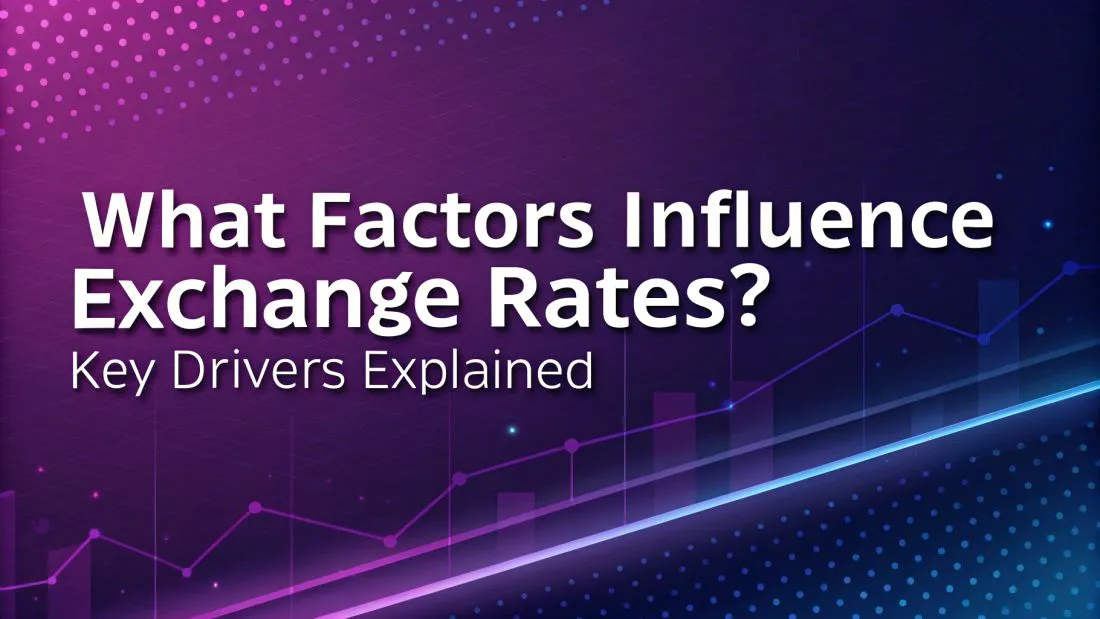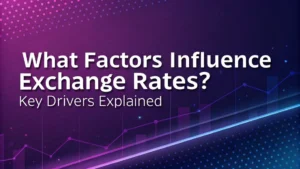Introduction
Currencies are the lifeblood of global trade and investment. Every day, trillions of dollars move across borders in the foreign exchange (forex) market. But if you’ve ever noticed how the value of the U.S. Dollar, Euro, or Indian Rupee changes, you may have asked: What factors influence exchange rates?
Exchange rate movements affect exporters, importers, investors, and even ordinary consumers buying goods from abroad. Understanding these drivers can help businesses plan better and investors protect their capital. In this blog, we’ll explore the factors influencing exchange rates, ranging from economic indicators and political stability to global events and market psychology.
Understanding Exchange Rates
An exchange rate is simply the price of one currency in terms of another. For example, if 1 USD = 83 INR, the exchange rate tells you how many Indian Rupees are required to buy one U.S. Dollar.
- How it works: Exchange rates are determined by supply and demand in the forex market. If demand for a currency rises, its value appreciates; if demand falls, the currency depreciates.
- Types:
- Fixed exchange rates – pegged to another currency, like the Hong Kong Dollar linked to USD.
- Floating exchange rates – determined by market forces, like the Euro or INR.
- Fixed exchange rates – pegged to another currency, like the Hong Kong Dollar linked to USD.
With this foundation, let’s dive into the key factors influencing exchange rates.
Economic Factors Influencing Exchange Rates
1. Interest Rates
Higher interest rates attract foreign investment because investors seek better returns. When a country raises its interest rates, its currency often strengthens as global capital flows in. Conversely, lower rates can weaken the currency.
2. Inflation Levels
A country with consistently low inflation typically sees its currency appreciate, because purchasing power remains strong. High inflation erodes currency value, making imports expensive and exports less competitive.
3. GDP Growth
Strong economic growth signals stability and prosperity. Investors are more likely to invest in countries with rising GDP, boosting demand for that country’s currency.
4. Trade Balance
If a country exports more than it imports, demand for its currency rises, leading to appreciation. A trade deficit, on the other hand, often causes currency depreciation.
These core economic indicators affecting exchange rates are closely watched by policymakers, traders, and investors.
Political and Social Factors
Politics play a huge role in exchange rate stability:
- Government Stability: Stable governments attract foreign investors, strengthening currency. Political uncertainty, corruption, or frequent policy shifts weaken it.
- Policy Decisions: Tax reforms, monetary policies, and trade agreements can all influence currency values.
- Geopolitical Conflicts: Wars or unrest discourage investment, leading to depreciation.
For example, countries with reliable governance often enjoy stronger currencies because investors see them as safe havens.
Market Sentiment and Speculation
Beyond hard data, market psychology is a powerful driver of currency fluctuations.
- Speculators: Forex traders buy or sell large volumes of currency, influencing short-term movements.
- Investor Confidence: Positive news (like credit rating upgrades) boosts currency demand, while negative headlines (like defaults) weaken it.
- Herd Behavior: Sometimes traders follow market momentum rather than fundamentals, amplifying volatility.
Thus, exchange rate fluctuations aren’t always about economics—they’re also about perception.
Global Events and External Factors
Currencies are sensitive to worldwide shocks:
- Natural Disasters & Pandemics: Events like COVID-19 reduced investor confidence, weakening currencies in affected countries.
- Commodity Prices: Oil-exporting countries (like Saudi Arabia or Russia) see their currencies tied to global crude prices. Gold and agricultural commodities also have similar effects.
- Central Bank Interventions: Banks may buy or sell currency reserves to stabilize exchange rates. For example, the Reserve Bank of India often intervenes to manage INR volatility.
These external factors influencing exchange rates show how global economics can ripple into local currencies.
Case Studies: Currency Fluctuations Explained
USD and Federal Reserve Policy
When the Federal Reserve increases interest rates, the USD typically strengthens as global investors flock to U.S. assets.
Brexit and the British Pound
The 2016 Brexit referendum caused the Pound to fall sharply due to political uncertainty, proving how political shocks directly hit exchange rates.
Emerging Market Crises
Countries like Turkey or Argentina have faced currency crashes due to inflation, debt burdens, and unstable policies.
Each case highlights how different factors influencing exchange rates—economic, political, or global—can combine to create major impacts.
Long-Term vs Short-Term Influences
Not all factors have the same time frame of impact:
- Long-Term Drivers: Structural economic performance, trade balance, and political stability.
- Short-Term Drivers: Market speculation, sudden global events, temporary interest rate changes.
Businesses hedge their risks using forward contracts, while investors diversify portfolios to manage these fluctuations.
Conclusion
Exchange rates may seem complex, but at their core, they’re shaped by a combination of economic fundamentals, political conditions, market psychology, and global events. The factors influencing exchange rates—from interest rates and inflation to speculation and crises—are interconnected, and understanding them is essential for businesses, policymakers, and investors alike.
By staying informed, you can anticipate fluctuations and make smarter decisions in the global marketplace.
Want to stay updated on global currency trends and insights into what drives them?
Subscribe to our newsletter for regular updates on factors influencing exchange rates and their impact on businesses worldwide.





